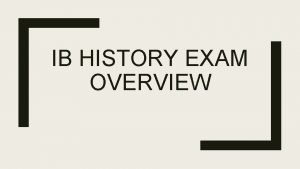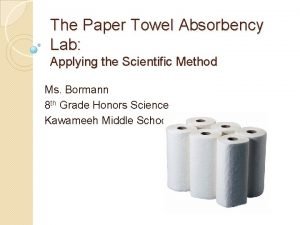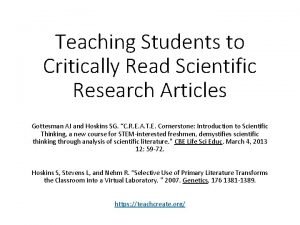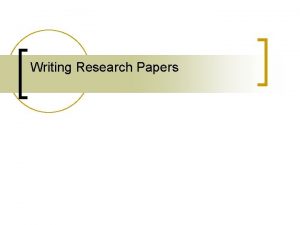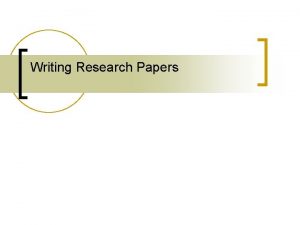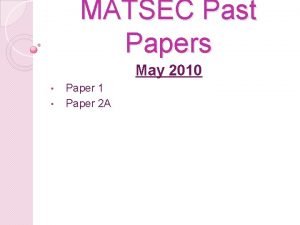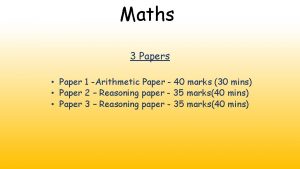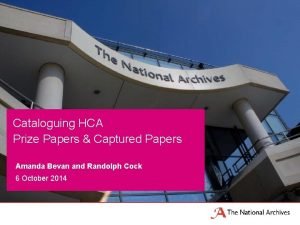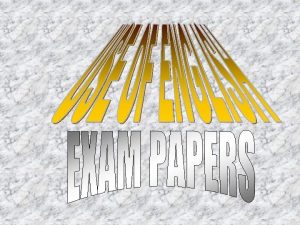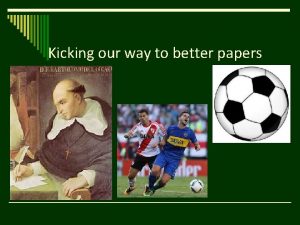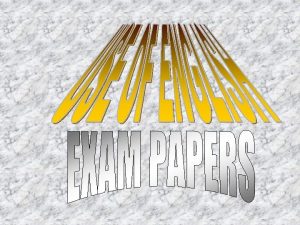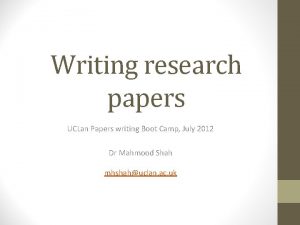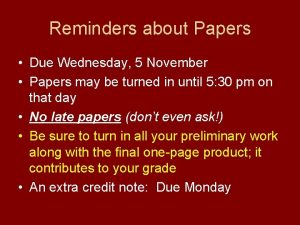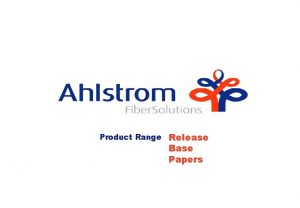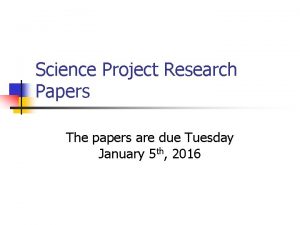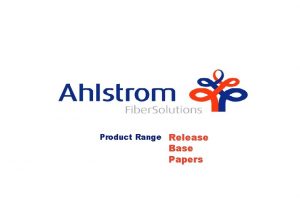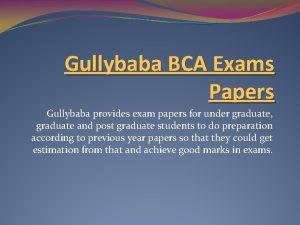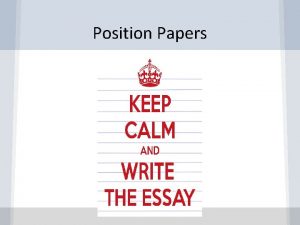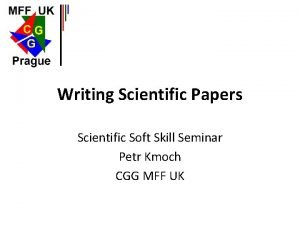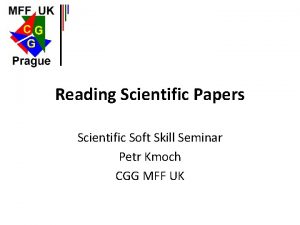Scientific Papers What is a scientific paper The







![Examples �Simulation and economic evaluation of natural gas hydrates [NGH] as an alternative to Examples �Simulation and economic evaluation of natural gas hydrates [NGH] as an alternative to](https://slidetodoc.com/presentation_image_h2/a03a36fcf7f4f9e3a9470a685cbe9f46/image-8.jpg)

























- Slides: 33

Scientific Papers

What is a scientific paper �The first publication of original research results �In a form whereby peers of the author can repeat the research and test the conclusions. �In a journal or other source readily available within the scientific community �Scientific papers are published in peer-reviewed publications

What Happens to Your Article? �Submitted to Editor �Editor’s “assessment” (reject; revise) �Sent to Reviewers �Reviewers reply to Editor �Editor’s decision (accept; reject; revise) �Back to you: revised version and letter �Editor may revert to Reviewers Note: It’s always the Editor who decides

What Does the Editor Look For ? �Originality �What’s new? �Content �Is there enough? �Simplicity �Can it be clearer, shorter?

Where do you publish? �Impact factors Review Period Readership

Elements of a Paper �Abstract �Keywords �Introduction �Methods (Details) �Results �Discussion �Conclusions �Acknowledgements �References

Title �The title is a precise of the contents. It should include specific words to indicate the following: �The topic: the main, general subject you are writing about. �The focus: a detailed narrowing down of the topic into the particular, limited area of your research. �The purpose: it is optional to tell the reader what kind of argumentation to expect.
![Examples Simulation and economic evaluation of natural gas hydrates NGH as an alternative to Examples �Simulation and economic evaluation of natural gas hydrates [NGH] as an alternative to](https://slidetodoc.com/presentation_image_h2/a03a36fcf7f4f9e3a9470a685cbe9f46/image-8.jpg)
Examples �Simulation and economic evaluation of natural gas hydrates [NGH] as an alternative to liquefied natural gas [LNG]

Authorship �Who gets authorship? �Any author listed on the paper’s title page should take public responsibility for its content �Some journals require authors to specify exactly their involvement in the manuscript (e. g. , study planning, data collection, data analysis, manuscript writing, manuscript editing).

How to list authors �Each listed author should have made an important contribution to the study being reported. �There is no “right way” to list authors. �Method 1 �The first author is the most senior. �The authors are listed in order of importance to the research.

How to list authors (2) �Method 2 �The first author is the one who did the majority of the work. �The authors are listed in order of importance to the research. �The last position is for the most senior author

Abstract �An abstract is a shortened version of the paper written for people who may never read the full version. It needs to be self-explanatory. �It is a brief summary of each of the main sections of the paper. �An abstract appears at the top of the page before the introduction. �A typical abstract is between 100 and 250 words. �It should be typed as a single paragraph (two maximum)

The abstract contains �The principle objectives and scope of the investigation. �Methods employed. �Summary of the main results. �Principle conclusions.

The abstract should not contain �Any information that is not in the paper itself. �Tables and figures. �Citations from other people's work.

Key Words �These are the most important words in your paper that are specifically related to your topic. �They are printed at the end of the abstract

The introduction �A research paper is shorter than a thesis. Its introduction is more precise and to the point. It also contains a brief literature survey. �Most of it is written in the past tense. �An introduction contains : �Purpose of the paper �The nature and scope of the problem investigated �Review of printed literature to orient the reader �Method of investigation, and reason for choosing it, if necessary

Methods and Materials �In this section the researcher cites all the specifics of the work done. �Most of it is written in the past tense. �This sections answers the following questions: - Where? Location of the work, if relevant. - What? What equipment and other materials were used in the research. They need to be thoroughly specified. - How? The procedures and methods used in the research. Every detail should be included especially if the method is new.

Results �This section follows Methods and Materials. �In this section you present the precise data and findings from the research, often using visuals to provide the information. �Written in past tense. �Data may be effectively presented in charts, tables, graphs, diagrams and photographs. They should be accompanied by explanatory text to highlight and interpret significant facts.

Discussion �This section follows Results. �In this section you write about your interpretation of your findings and your evaluation of the research. �In particular, you give your opinion as to whether the work supported and proved your hypothesis, or whether it did not.

Discussion (2) �Present principles, relationships and generalizations shown by the results. �Point out any exceptions or any lack of correlation. �Show your results and interpretations agree (or disagree) with previous published work. �Discuss theoretical implications of your work, as well as any possible practical applications

Conclusions �Points to include in a conclusion: �A restatement of the research problem �A summary of your main points. �Your evaluation of the topic. �Shortcomings of the research. �Suggestion for further investigations or work in the topic. �State your conclusions as clearly as possible. �Conclusion is present tense

Acknowledgement �Who do you acknowledge? �Any individual who gave significant technical help �Financial assistance. �Source of special equipment.

Plagiarism �Plagiarism is using another person's writing as if it was your own. �It is a form of theft. �All academic, scientific, technical and research writing must document all sources used.

Types of Information Requiring a Citation �The exact words of another person �Numerical information that is not common knowledge �Someone’s specific argument, theory, thesis or opinion �Controversial information (if two or more sources disagree).

Types of Information Not Requiring a Citation �Common knowledge/field-specific common knowledge �Information found in dictionaries �Statistics and information that can be easily found in several sources and is not likely to vary from source to source

Evaluating Information Sources �Relevance �Reliability �Reasonableness �do the ideas presented make sense? �are the ideas and information presented in the source material reasonably consistent with the ideas and information presented in other similar sources?

Format of references Reference to a book. �names of author(s). �title of the book, only the first word need to have a capital letter. �edition. �name of the publisher. �city where published. �year of publication. B. Yegnanarayana, "Artificial neural networks", 12 th edition, Prentice-Hall, New Delhi (2006).

Reference to an article from a journal �names of author(s). �title of the paper, only the first word need to have a capital letter. �title of journal. �volume number. �year of publication. �inclusive page numbers. M. J. Nui, R. Munipalli, N. B. Morley and M. A. Abdou, "Validation strategies of HIMAG in interfacial flow computation for fusion applications, " Fusion Eng. & Design, 81 (2006) 1535 – 1541.

Reference to material from the internet �names of author(s), if known �title of the extract. �title of the complete work, if known. �name of producer of online website. �internet address of the quoted material. �date that the site was accessed online �Example : �Kazimi, M. S. , Czerwinski, K. R. , Driscoll, M. J. , Hejzlar, P. , Meyer, J. E. On the Use Of Thorium in Light Water Reactors. (April 1999) (Accessed april 15, 2015)Available at: <http: //hdl. handle. net/1721. 1/75140>

Final check �Make sure of the following: �All paper written with the same font style (no fancy fonts). �Titles are all written in the same style. �Figures, tables, equations, …. numbering is correct. �All illustrations and equations are referred to in text. �Other people’s work is cited inside paper. �References written properly and in correct order. �No mistakes

Assignment �You will be provided with an accepted scientific paper and the layout of “ Journal of Karary University for Engineering and Science (JKUES) “ �Put the paper into the new layout �Prepare a presentation as you are the author

What I usually look at �Fonts types �Font size �Are the figures and/or tables referred to in the text? �Are the references cited in the text? �Are the references written correctly?

Questions ?
 Edexcel language paper 2
Edexcel language paper 2 Ib history paper 1 rights and protest past papers
Ib history paper 1 rights and protest past papers English general paper paper 2 comprehension
English general paper paper 2 comprehension Aice general paper 1 exam
Aice general paper 1 exam Paper towel absorbency experiment
Paper towel absorbency experiment Scientific paper
Scientific paper Scientific white paper
Scientific white paper Frameset trong html5
Frameset trong html5 Số.nguyên tố
Số.nguyên tố đặc điểm cơ thể của người tối cổ
đặc điểm cơ thể của người tối cổ Vẽ hình chiếu vuông góc của vật thể sau
Vẽ hình chiếu vuông góc của vật thể sau Các châu lục và đại dương trên thế giới
Các châu lục và đại dương trên thế giới Thang điểm glasgow
Thang điểm glasgow Thế nào là hệ số cao nhất
Thế nào là hệ số cao nhất ưu thế lai là gì
ưu thế lai là gì Hệ hô hấp
Hệ hô hấp Tư thế ngồi viết
Tư thế ngồi viết Cái miệng nó xinh thế
Cái miệng nó xinh thế Cách giải mật thư tọa độ
Cách giải mật thư tọa độ Bổ thể
Bổ thể Tư thế ngồi viết
Tư thế ngồi viết Thẻ vin
Thẻ vin Thể thơ truyền thống
Thể thơ truyền thống Hát lên người ơi
Hát lên người ơi Các châu lục và đại dương trên thế giới
Các châu lục và đại dương trên thế giới Từ ngữ thể hiện lòng nhân hậu
Từ ngữ thể hiện lòng nhân hậu Khi nào hổ con có thể sống độc lập
Khi nào hổ con có thể sống độc lập Diễn thế sinh thái là
Diễn thế sinh thái là Vẽ hình chiếu vuông góc của vật thể sau
Vẽ hình chiếu vuông góc của vật thể sau Ví dụ giọng cùng tên
Ví dụ giọng cùng tên 101012 bằng
101012 bằng Tỉ lệ cơ thể trẻ em
Tỉ lệ cơ thể trẻ em Lời thề hippocrates
Lời thề hippocrates đại từ thay thế
đại từ thay thế

